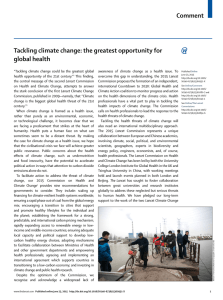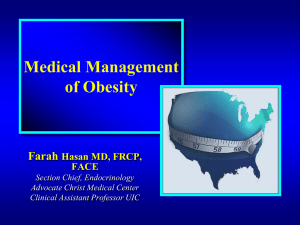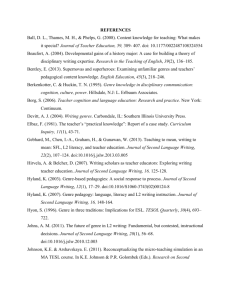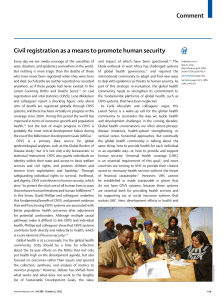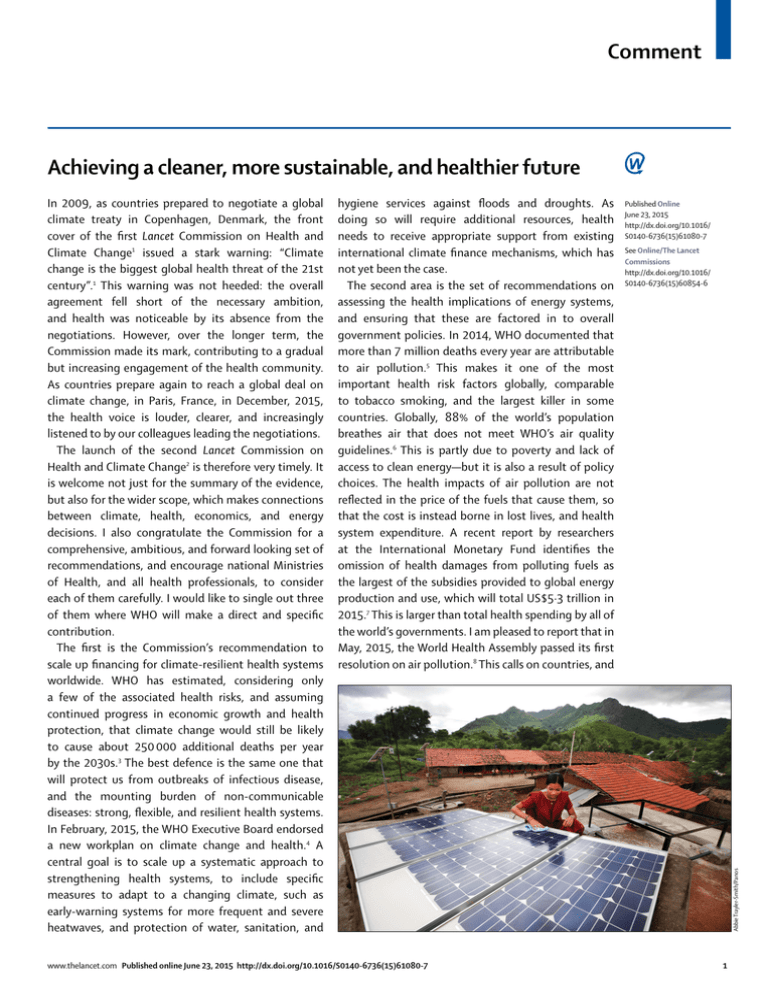
Comment
Achieving a cleaner, more sustainable, and healthier future
hygiene services against floods and droughts. As
doing so will require additional resources, health
needs to receive appropriate support from existing
international climate finance mechanisms, which has
not yet been the case.
The second area is the set of recommendations on
assessing the health implications of energy systems,
and ensuring that these are factored in to overall
government policies. In 2014, WHO documented that
more than 7 million deaths every year are attributable
to air pollution.5 This makes it one of the most
important health risk factors globally, comparable
to tobacco smoking, and the largest killer in some
countries. Globally, 88% of the world’s population
breathes air that does not meet WHO’s air quality
guidelines.6 This is partly due to poverty and lack of
access to clean energy—but it is also a result of policy
choices. The health impacts of air pollution are not
reflected in the price of the fuels that cause them, so
that the cost is instead borne in lost lives, and health
system expenditure. A recent report by researchers
at the International Monetary Fund identifies the
omission of health damages from polluting fuels as
the largest of the subsidies provided to global energy
production and use, which will total US$5·3 trillion in
2015.7 This is larger than total health spending by all of
the world’s governments. I am pleased to report that in
May, 2015, the World Health Assembly passed its first
resolution on air pollution.8 This calls on countries, and
www.thelancet.com Published online June 23, 2015 http://dx.doi.org/10.1016/S0140-6736(15)61080-7
Published Online
June 23, 2015
http://dx.doi.org/10.1016/
S0140-6736(15)61080-7
See Online/The Lancet
Commissions
http://dx.doi.org/10.1016/
S0140-6736(15)60854-6
Abbie Trayler-Smith/Panos
In 2009, as countries prepared to negotiate a global
climate treaty in Copenhagen, Denmark, the front
cover of the first Lancet Commission on Health and
Climate Change1 issued a stark warning: “Climate
change is the biggest global health threat of the 21st
century”.1 This warning was not heeded: the overall
agreement fell short of the necessary ambition,
and health was noticeable by its absence from the
negotiations. However, over the longer term, the
Commission made its mark, contributing to a gradual
but increasing engagement of the health community.
As countries prepare again to reach a global deal on
climate change, in Paris, France, in December, 2015,
the health voice is louder, clearer, and increasingly
listened to by our colleagues leading the negotiations.
The launch of the second Lancet Commission on
Health and Climate Change2 is therefore very timely. It
is welcome not just for the summary of the evidence,
but also for the wider scope, which makes connections
between climate, health, economics, and energy
decisions. I also congratulate the Commission for a
comprehensive, ambitious, and forward looking set of
recommendations, and encourage national Ministries
of Health, and all health professionals, to consider
each of them carefully. I would like to single out three
of them where WHO will make a direct and specific
contribution.
The first is the Commission’s recommendation to
scale up financing for climate-resilient health systems
worldwide. WHO has estimated, considering only
a few of the associated health risks, and assuming
continued progress in economic growth and health
protection, that climate change would still be likely
to cause about 250 000 additional deaths per year
by the 2030s.3 The best defence is the same one that
will protect us from outbreaks of infectious disease,
and the mounting burden of non-communicable
diseases: strong, flexible, and resilient health systems.
In February, 2015, the WHO Executive Board endorsed
a new workplan on climate change and health.4 A
central goal is to scale up a systematic approach to
strengthening health systems, to include specific
measures to adapt to a changing climate, such as
early-warning systems for more frequent and severe
heatwaves, and protection of water, sanitation, and
1
Comment
the WHO Secretariat, to scale up their response to this
major health issue, strengthening the health sector’s
contribution to decision making across sectors at
local and national levels to clean the air and maximise
health benefits. It also underscores opportunities to
achieve cobenefits from actions that reduce emissions
of warming climate-altering pollutants and at the
same time improve health. We will indeed address the
challenge of air pollution, and help guide countries
to, wherever possible, make choices that also help to
achieve climate change goals.
Third, the Commission highlights the need for
monitoring and assessment of progress, similar to the
Countdown to 2015 initiative9 that has helped to drive
progress on reducing maternal and child mortality.
This is critical: what gets measured gets done. Last
year, at the first WHO global Conference on Health and
Climate, the Executive-Secretary of the United Nations
Framework Convention on Climate Change Secretariat
and I committed to produce country-specific profiles
on health and climate change in advance of the Paris
climate change conference. These compile the best
available evidence on climate risks to health, on the
opportunities to improve health while reducing
greenhouse gas emissions, and on the status of
country policies. These can also serve as the baseline for
monitoring future progress.
Finally, I draw attention to the Commission’s
message that the health community has a vital part to
play in accelerating progress to tackle climate change.
To quote UN Secretary-General Ban Ki-moon: “There is
no plan B; there is no planet B”. Health professionals
2
have been at the forefront of social changes, such as
those that have gradually made smoking increasingly
unacceptable, driving down smoking rates—and
saving many lives. I endorse the call for the health
community to support the growing movement for a
cleaner, more sustainable, and healthier future.
Margaret Chan
World Health Organization, CH-1211 Geneva 27, Switzerland
faresc@who.int
I am Director-General of WHO. I declare that I have no competing interests.
© 2015. World Health Organization. Published by Elsevier Ltd/Inc/BV. All
rights reserved.
1
2
3
4
5
6
7
8
9
Costello A, Abbas M, Allen A, et al. Managing the health effects of
climate change: Lancet and University College London Institute for
Global Health Commission. Lancet 2009; 373: 1693–733.
Watts N, Adger WN, Agnolucci P, et al. Health and climate change: policy
responses to protect public health. Lancet 2015; published online
June 23. http://dx.doi.org/10.1016/S0140-6736(15)60854-6.
WHO. Quantitative risk assessment of the effects of climate change on
selected causes of death, 2030s and 2050s. Geneva: World Health
Organization, 2014.
WHO. Health and the environment: climate and health: outcome of the
WHO Conference on Health and Climate. Geneva: World Health
Organization, 2015. http://apps.who.int/gb/ebwha/pdf_files/EB136/
B136_16-en.pdf (accessed June 8, 2015).
WHO. Burden of disease from the joint effects of household and ambient
air pollution for 2012. Geneva: World Health Organization, 2014. http://
www.who.int/phe/health_topics/outdoorair/databases/FINAL_HAP_
AAP_BoD_24March2014.pdf?ua=1 (accessed June 8, 2015).
WHO. Air quality deteriorating in many of the world’s cities. Geneva:
World Health Organization, 2014. http://www.who.int/mediacentre/
news/releases/2014/air-quality/en/ (accessed June 8, 2015).
Coady D, Parry I, Sears L, Shang B. How large are global energy subsidies?
IMF Working Paper. WP/105/105. May, 2015. http://www.imf.org/
external/pubs/ft/wp/2015/wp15105.pdf (accessed June 8, 2015).
World Health Assembly. Health and the environment: addressing the
health impact of air pollution. Resolution WHA68.8. May 26, 2015.
http://apps.who.int/gb/ebwha/pdf_files/WHA68/A68_R8-en.pdf
(accessed June 8, 2015).
Countdown to 2015: Maternal, Newborn, and Child Survival.
http://www.countdown2015mnch.org/ (accessed June 8, 2015).
www.thelancet.com Published online June 23, 2015 http://dx.doi.org/10.1016/S0140-6736(15)61080-7

